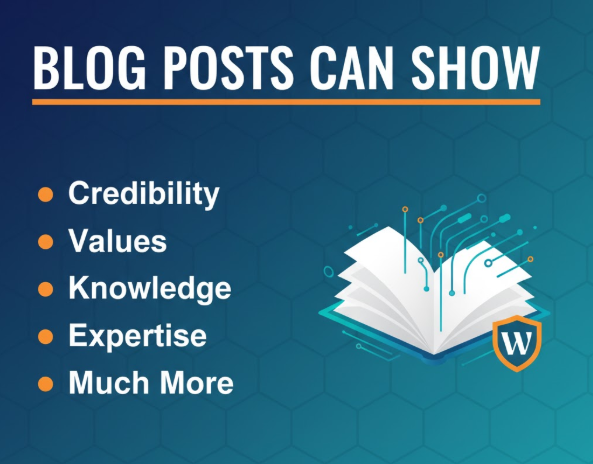
Proven SEO Strategies: The Link Between Blog Posts and Conversions

Blogs aren’t just words. They don’t just take up space on a site. When written properly, they can help guide a reader toward taking real action. In terms of effective growth and SEO strategies, blog content can be part of a larger approach to search visibility, audience engagement, and more.

These methods are not about shortcuts or guesswork. They are about guiding your content so that readers feel informed, comfortable, and ready to take the next step.
Whether that next step leads to a phone call, a form fill, or a direct purchase, the quality and focus of your content can shape how effectively your site turns visitors into clients.
The foundation of conversion-driven blogging is focus: writing for a specific person, addressing their needs directly, and offering clarity rather than noise.
This is not always easy, especially because many businesses want to talk about themselves. But blog posts that convert are always posts that speak to the reader’s goals, questions, pains, or interests instead of simply stating accomplishments.
How Blog Content Guides People Toward Action
A blog post acts as a conversation starter, a helpful guide, and sometimes even a trust-building introduction. When done well, blogs can be a strategic component of digital marketing in Los Angeles and elsewhere. They help humanize a brand and show potential clients what working with you actually feels like.
There are several ways blogs move a reader toward a conversion:
- They answer questions people are actively searching for.
• They demonstrate your credibility without bragging.
• They show your values, professionalism, and knowledge in real-world contexts.
• They give your audience a reason to stay on your site longer.
• They create pathways to contact forms, service pages, or consultation booking pages.
This is where thoughtful SEO strategies come into play. How? By guiding how your content is structured so that both people and search engines can find what you offer.

Topical Relevance and Search Signals
The topics you choose should connect directly to real concerns from real customers. Focusing too broadly can dilute your message and lose the chance to speak to someone who is ready to act.
That means following SEO strategies that help you identify phrases, questions, and concerns your audience frequently searches.
Key characteristics of relevant blog content include:
- Relates to services you directly provide
• Reflects questions your support or sales teams hear often
• Uses terminology your audience uses, not internal jargon
• Shows familiarity with the day-to-day challenges of your target client
When your content aligns with real conversations, the path to conversion becomes clearer.
Advanced SEO Strategies: Elements That Make a Blog Post Convert
Beyond keyword research and on-page optimization, a good conversion-driven blog focuses on clarity and helpfulness. When we produce content, we take into account how readers navigate, absorb, and evaluate information.
This can also be linked to broader efforts like our web design in Los Angeles. With that, we utilize layout and user interface to positively affect how easily a reader can move forward after reading.
A strong conversion-focused blog usually contains:
- A relatable opening that shows the reader you understand their concern
• Real guidance or steps they can apply immediately
• Clear, simple language that avoids industry buzzwords
• Subtle, natural invitations to learn more, schedule a call, or request help
• Internal links that guide readers to relevant service pages
• A consistent sense of tone and professionalism
Remember: SEO strategies also influence structure. Well-placed headers, natural keyword use, and internal linking create a blog post that is both readable and optimized for visibility.

Tone, Voice, and Value
If the blog feels overly promotional or too eager to sell, readers often disengage. A more conversational, guiding tone is typically more persuasive than a pitch-heavy one. The goal is to make the reader feel confident and supported—not pressured.
Ways to shape tone effectively:
- Speak in a reassuring, knowledgeable voice
• Address concerns directly and empathetically
• Avoid exaggerated claims or vague promises
• Offer specific examples or use cases
• Invite the reader to continue learning with you, rather than telling them to
Common Mistakes That Reduce Blog Effectiveness
Even experienced marketers and content teams can sometimes miss the mark when building blogs aimed at conversion. These mistakes are often subtle but can add up to lost opportunities.
The challenges can also overlap. For example, in our work providing reputation management Los Angeles, we’ve seen plenty of clients who come to us with social media posts that are just selling, just promoting. Remember: consistency in messaging and tone across platforms is key.
Some frequent stumbling points include:
- Writing content that focuses too much on the business, not the customer
• Overusing keywords in a way that feels repetitive or forced
• Using overly long paragraphs that make readers skim and miss essential points
• Neglecting internal links, calls to action, or navigation clarity
• Leaving out the emotional side of decision-making
In many cases, writers are doing everything they believe is necessary, but a few small adjustments could significantly improve reader engagement and conversion performance.
Keyword Placement vs. Keyword Stuffing
SEO strategies are most effective when used naturally. Keywords should appear where they fit organically, rather than being forced into every sentence. When keywords disrupt the flow of the language, readers feel it—and may click away.
A few simple reminders:
- Prioritize clarity and readability
• Place keywords near the beginning of sections where appropriate
• Never sacrifice tone or meaning to add a keyword
• Think about how a human—not just a search engine—will read your content
A blog is an opportunity. It’s an opportunity for you to make a specific, emotional connection. You don’t want to waste that.
As this article from the Harvard Gazette says, “when you guide someone on a line of thought, with its tangles and dead ends and reorientations, you build their understanding.”
That doesn’t mean you want to put a lot of “tangles and dead ends and reorientations” into your blog. But, you do want to make sure that your blog builds the reader’s understanding.
A Practical Checklist Before Publishing Your Blog
Before posting, review your blog with fresh eyes. It can help to step away, return later, and read it as if you are your own customer. This stage of review also fits into broader ongoing content practices, including LA social media management, where messaging should feel cohesive and aligned across platforms.
Before publishing, make sure your blog:
- Speaks directly to a reader’s need or question
• Offers information that is genuinely useful
• Uses SEO strategies without sounding mechanical
• Includes clear paths for readers to learn more or take action
• Has internal links to relevant portions of your site
• Has headings and spacing that make it easy to skim
• Feels confident, not aggressive
• Reflects the voice and values of your brand
Blogs don’t convert because they are flashy. They convert because they are thoughtful, clear, helpful, and strategically aligned with a reader’s intent.
Making SEO Strategies Work
At Website Depot, we help businesses create blog content that contributes to genuine growth—content that serves your audience while working within broader SEO strategies to help your site become more discoverable. The connection between blog posts and conversions is not theoretical. It’s measurable, repeatable, and scalable when done with care.